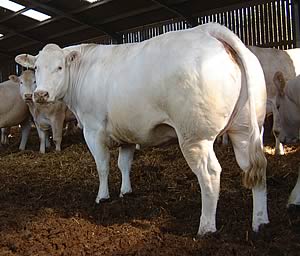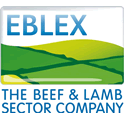2009-07-31
The Druk herd owned by Christopher Lewis and Nick Cobbold of Faringdon, Oxfordshire, has been recognised by EBLEX as the Most Improved Herd for the British Blonde breed, for the second year running.
Druk British Blonde
 |
The award is presented by the EBLEX Beef Better Returns Programme (Beef BRP) to the recorded herd that shows the greatest genetic gain for commercial traits over a 12-month period. There is a separate award for each of ten UK breeds.
Christopher Lewis first moved to Oxfordshire in 1959 when he acquired the initial 80ha (196 acre) farm. Now he and his stepson, Nick Cobbold, manage 800ha (2000 acres) along the River Thames. The farm is mainly down to arable crops, but unploughable land such as the water meadows is used to graze cattle.
Mr Lewis was one of the first people to import Blonde cattle, buying in six heifers from France, 30 years ago. Now the herd is split into two, with 60% calving indoors in April/May, and the rest calving outside in October/November before being housed for the winter.
As soon as the spring-born calves have been de-horned and vaccinated, they are turned out onto the river meadows. They are weaned at six months of age. Everything is kept indoors during the winter – dry cows are fed ad-lib low quality grass silage, and the youngstock and milking cows have access to forage maize fed through a mixer wagon.
All stock not retained or sold for breeding are sold deadweight, and their carcase grades recorded and referred back to each animal’s sire and dam.
Passion for recording
Mr Lewis is passionate about performance recording and has always been a strong advocate of using figures as a management tool.
“You wouldn’t buy a racehorse or washing up liquid without proof of performance,” says Mr Lewis. “With a crop of wheat or barley, cereal growers weigh up how a variety performs against its competitors. Selecting breeding stock should be done on a similar basis.
“Many people argue you can judge an animal by eye. Of course an animal needs to look reasonable, but it’s the figures that really count.”
Mr Lewis only buys recorded bulls to serve his cows, although the choice is limited as so few British Blonde breeders record.
Breeding females are replaced at a rate of 10-15% per year. Their performance figures are of paramount importance, but temperament and looks are also taken into consideration.
“We usually find that physical traits and good figures go hand in hand,” explains Mr Cobbold. “Nervous flighty animals are not good converters, and seldom have good performance figures.”
Repeat business
Mr Lewis sells to several dairy and suckler cow producers who are looking for a good value, high quality, easy calving bull. Most are sold off the farm, and the buyers appreciate being able to see the sire, dam and other progeny, as well as being able to examine their Estimated Breeding Values (EBVs).
Richard Hutt, of Aylesbury, has bought eight bulls from Mr Lewis since 1981, for his herd of 50 spring calving Simmental cows. Young bulls are sold at around 14 months, finished on home-grown barley and sugarbeet. Heifers are finished at two years of age off grass.
Since using the Druk bulls, growth rates and carcase weights have increased, and conformation grades have improved. The animals are finishing faster and heavier.
“I only buy recorded stock and particularly look for EBVs for traits such as growth rate, ease of calving and muscle depth, as these are good indicators of future performance,” says Mr Hutt. “It helps to justify the investment in the animal.”
John Peel, of Dudgrove Farm, Fairford, Gloucestershire is another of
Mr Lewis’ regular customers. He has a herd of 100 suckler cows which calve in the spring. All the progeny is fattened and sold deadweight.
Bulls are reared as barley beef and finish at 12 months of age, achieving weights of around 600kg. Heifers finish at around 15-18 months, killing out at 520kg. All achieve at least R 4L carcase classification.
“I always buy my bulls from Lewis Partnership and have bought ten to date,” says Mr Peel. “They have a great understanding of performance recording and I value their opinion when looking for new stock. They always have figures to support their animals, which is very valuable.”
EBLEX breeding specialist Samuel Boon agrees: “EBVs are measurements of genetic potential and provide a reliable insight into the effect a bull could have on the herd.
“It means producers can make informed purchasing decisions rather than leaving it to chance, and hoping the chosen bull will deliver on the commercially important traits.
“All the winners of the Improved Herd Awards record the performance of their herds. All are providing valuable information that can help customers produce animals that make them money because they meet processor/retailer and consumer demand, and do so as efficiently as possible.
“I congratulate Christopher and Nick on the excellent job they are doing with the Druk herd and the British Blonde breed.”
 Upsall Herd Wins EBLEX Award for Beef Shorthorn Breed Upsall Herd Wins EBLEX Award for Beef Shorthorn Breed
 Andreayas Herd Wins EBLEX Award for British Blue Breed Andreayas Herd Wins EBLEX Award for British Blue Breed
 Westwilmer Herd Wins EBLEX Award for Aberdeen Angus Breed Westwilmer Herd Wins EBLEX Award for Aberdeen Angus Breed
|



